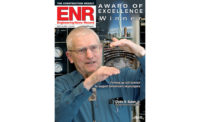Engineers favor deep foundations when there are very large design loads, poor soil at shallow depth or site constraints, such as adjacent structures. Many deep foundations are put in place by driven piles or drilled shafts. And most foundation contractors tend to specialize in one method or the other.
"I grew up in a pile-driving family," says Mike Wysockey, president of Thatcher Foundations Inc., Gary, Ind. "My father took over the firm, which was founded in 1946, in the early 1970s." The pile-driving "market in general has been picking up some, with bigger firms trying to muscle into the deep foundation market. Firms are chasing the work really hard."
Thatcher performs mostly building work, as well as sheet piles for retaining walls and dock walls. Its main competitors are Case Foundation and Hayward Baker, both owned by the Keller Group.
One recent development that Wysockey has seen is the introduction of "bigger new H-pile sections. They used to be 14 inches. Now they make 16-in. and 18-in. H-pile that can hold more load. They can support a bigger hammer. In some ways it's easier to drive bigger piles. Bigger, stiff beams are a conduit of energy."
Van Hogan, director of development at the Pile Driving Contractors Association, agrees with that view, commenting that "contractors are driving larger piles that require bigger hammers, and are trying to get higher capacities out of these piles." He points towards improvements in equipment, as well.
"Hammers have made improvements, taking great steps to reduce emissions. Hydraulic hammers are much improved, better insulated, creating far less noise," he explains. Some hammers now "have a long drive cap extended so it fits down several feet over a pile, so you don't have to have leads," or vertical beams that guide the hammer and the pile. "
High-frequency variable moment hammers "have become more common in the last five years," Wysockey adds. "They've really taken over in the urban market. Their vibratory energy is less damaging to adjacent structures."
Drilled shafts, or caissons, also have gradually evolved. Bob Schock, president of Case Foundation Co., based in Roselle, Illinois, has devoted almost four decades to the drilled-shaft side of the market. "I joined geotechnical engineering firm Soil Testing Services as a technician, then joined Caisson Corp. in the early 1980s as the hand-dug caisson era was fading and becoming a mechanized process. Caisson was acquired by Case in 1983."
The firm's specialty "is drilled heavy foundations, usually installed in clusters for tall buildings," says Schock. "We did 7 World Trade Center [New York], the John Hancock Center [Chicago], and the Sears Tower [Chicago] all on large-diameter drilled caissons. We do bridges. We also do foundations for electrical transmission line towers and electrified rail lines."
The drilled shaft industry "blossomed" in the 1950s and 60s with the development of larger diameter drills, Schock notes.
"Case has been a pioneer in a lot of ways, such as excavated rock sockets. Originally they were excavated by hand, then by coring tools, and now by high-pressure air hammers. We've been at the forefront of augercast piles over the past 10 or 12 years. We do them up to 48 in. diameter. The stem of the auger is hollow. You pump high-strength grout through the stem. You're casting a pile in the ground. It's an outgrowth of the drilled shaft industry."
In addition to many firms active across the world, the wide scope of the foundation market is reflected by the existence of the three major professional associations, the Pile Driving Contractors Association, the Association of Drilled Shaft Contractors, and the Deep Foundation Institute, which includes firms from both the pile driving and drilled shaft sectors.
Even so, there is no central information source for this specialized business. While ENR has attempted to dig up the greatest examples of various deep foundation jobs in our slideshow, this list is not comprehensive. We urge readers to contact us with other records for consideration.




















Post a comment to this article
Report Abusive Comment